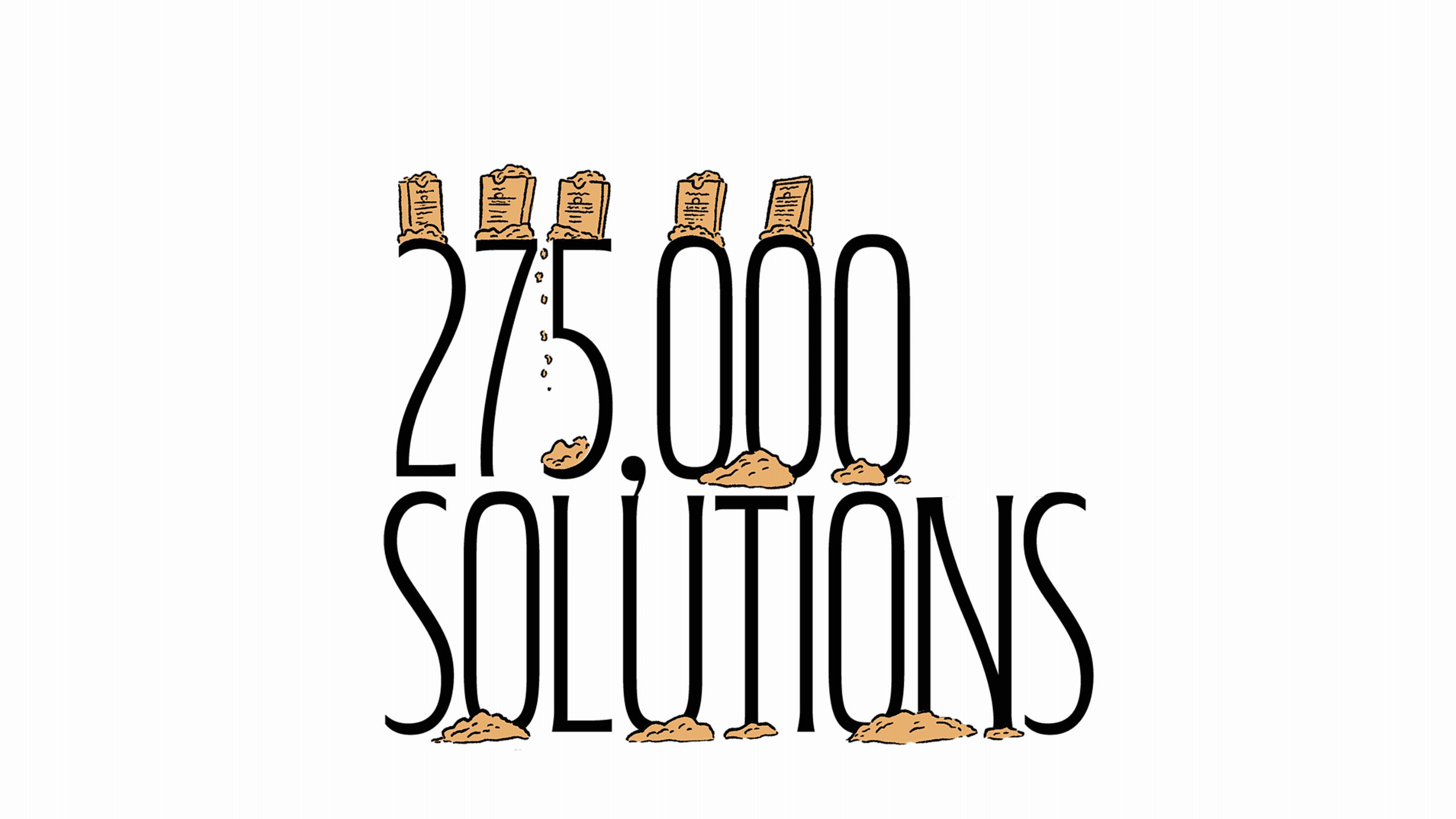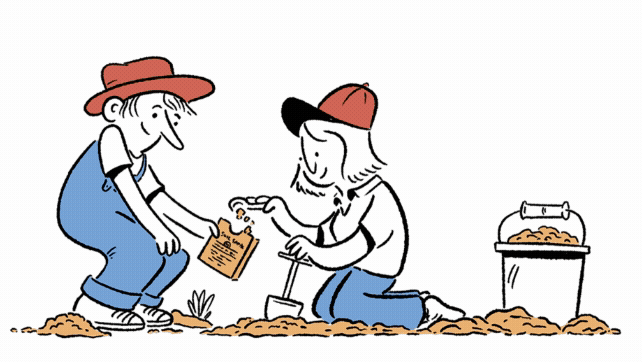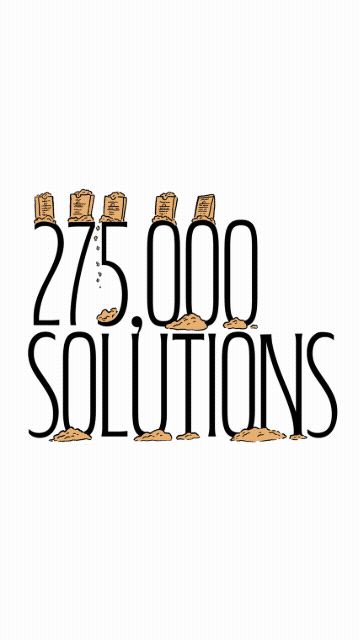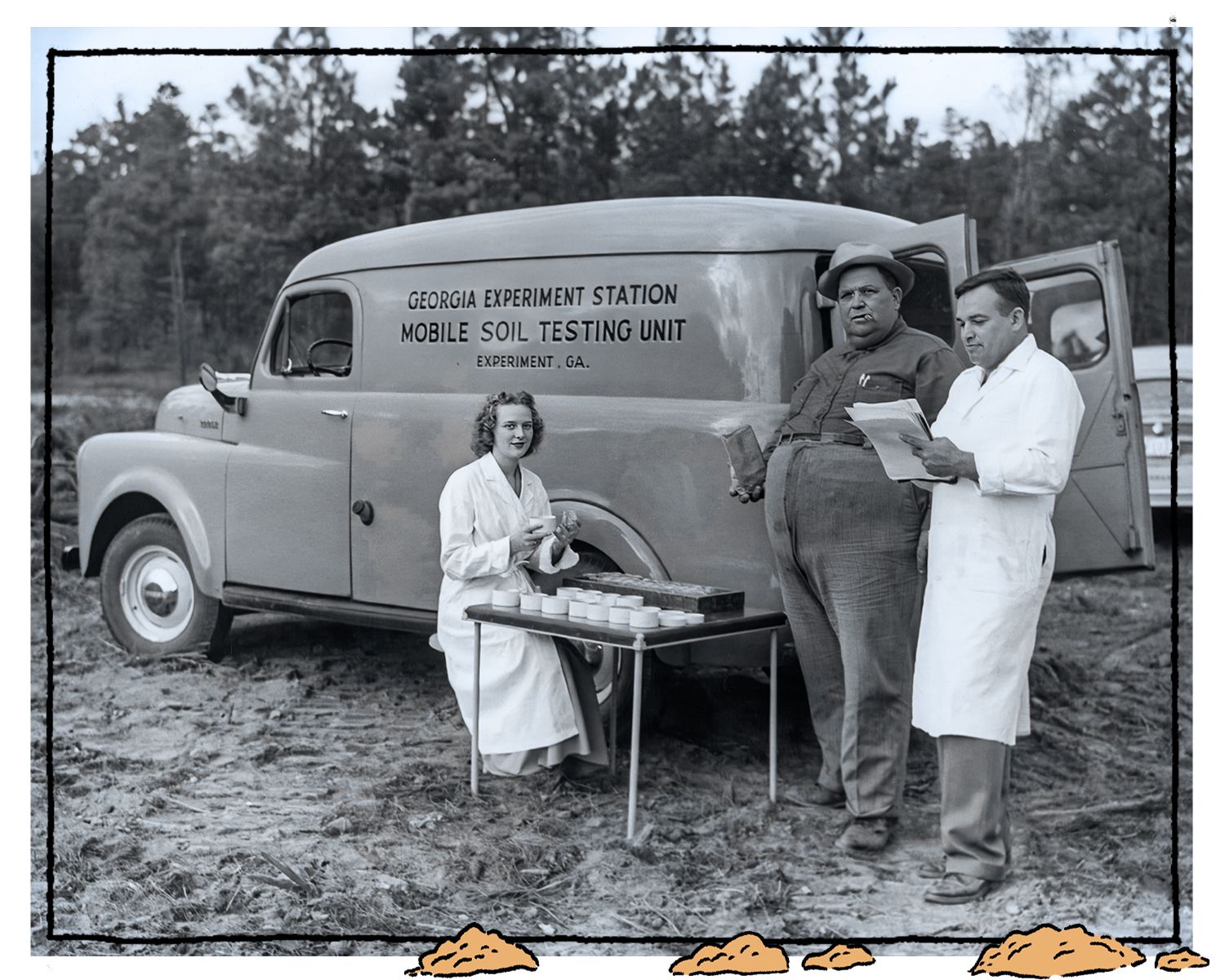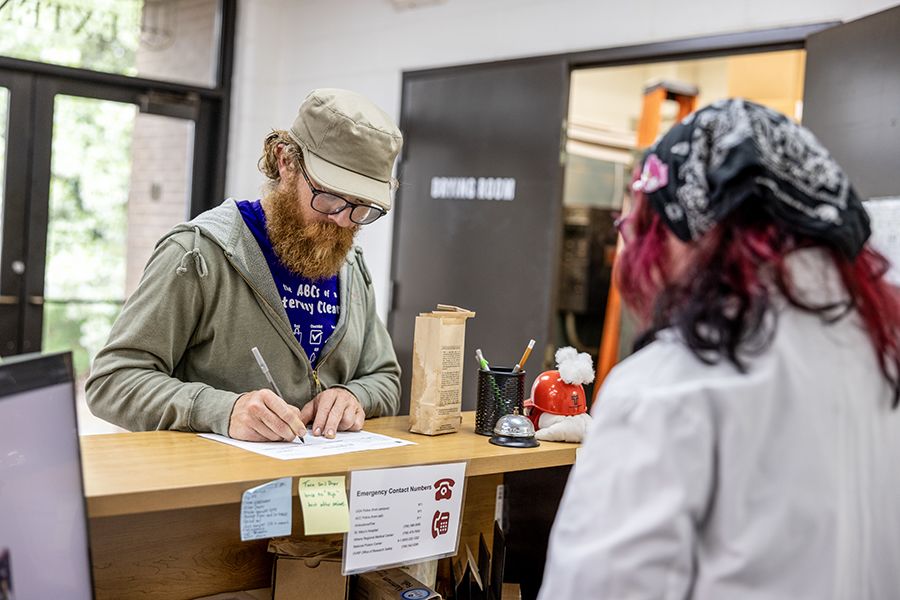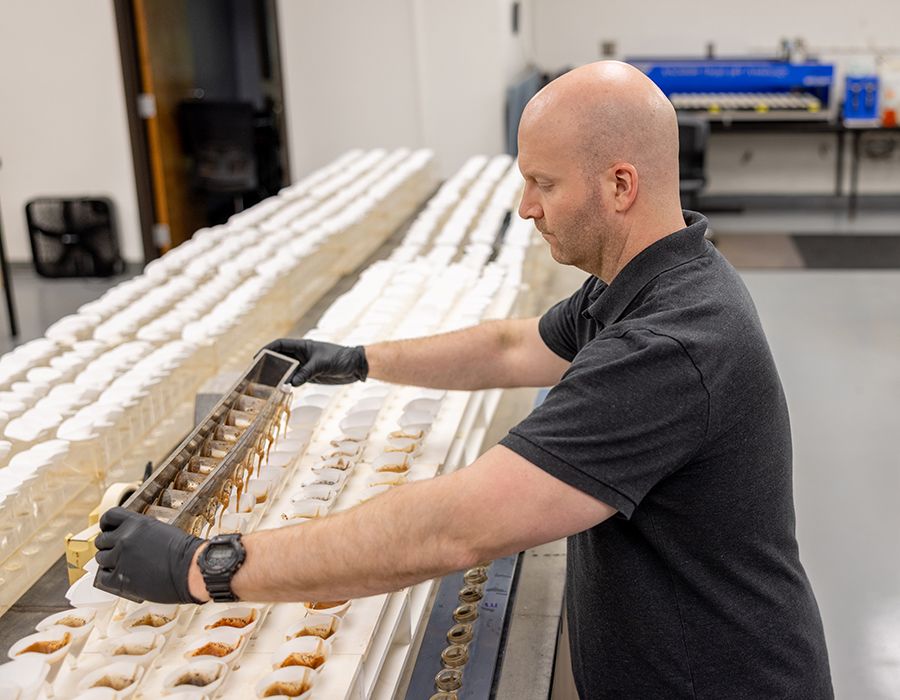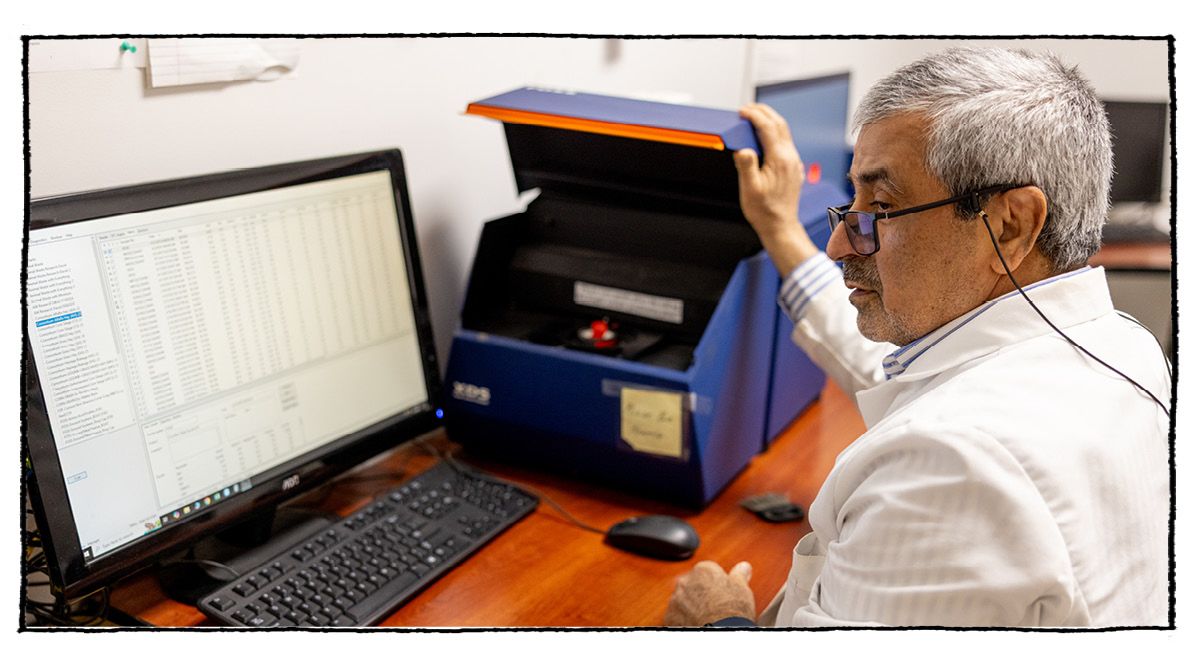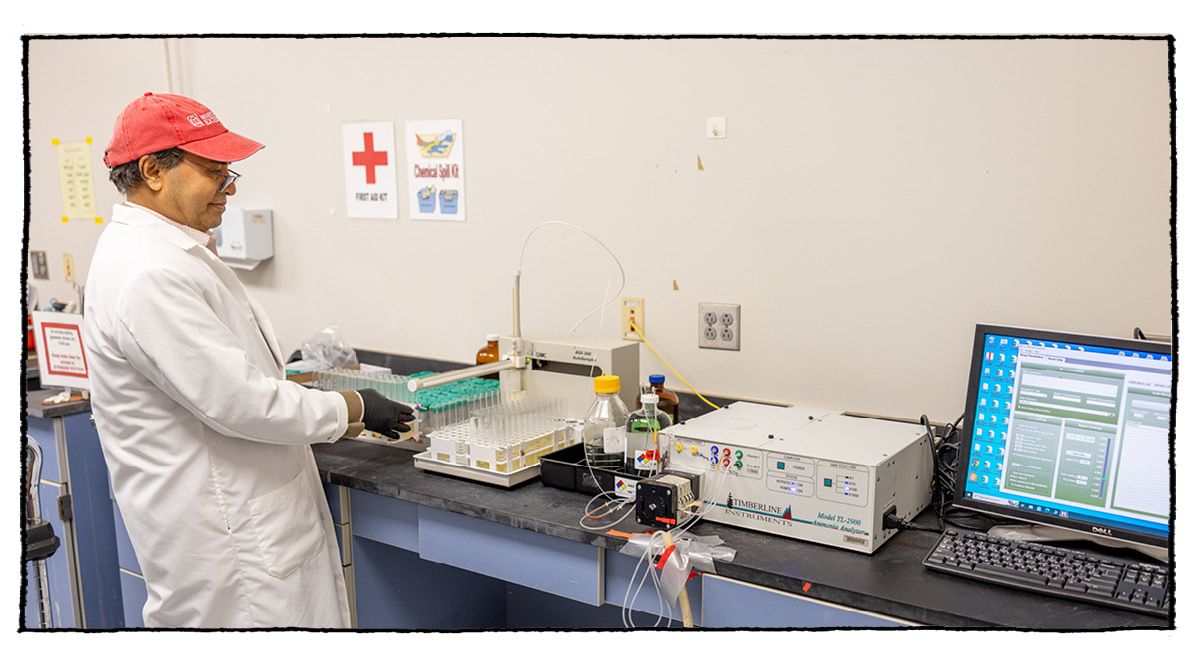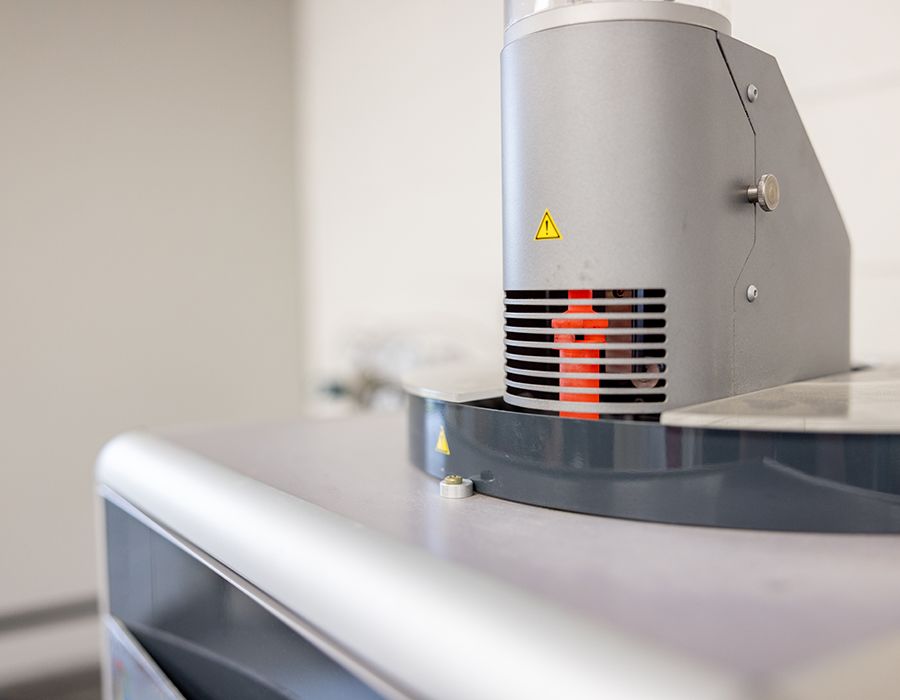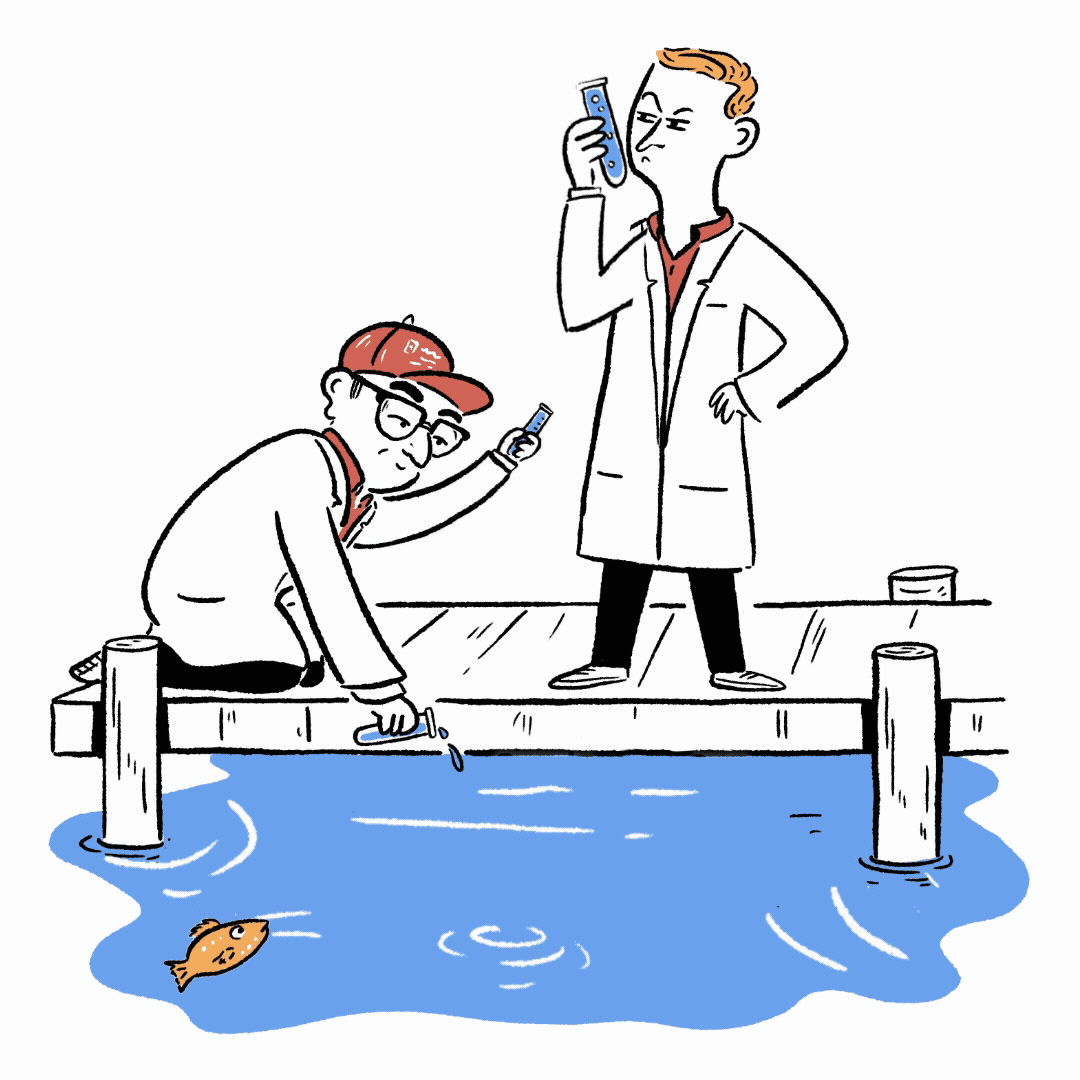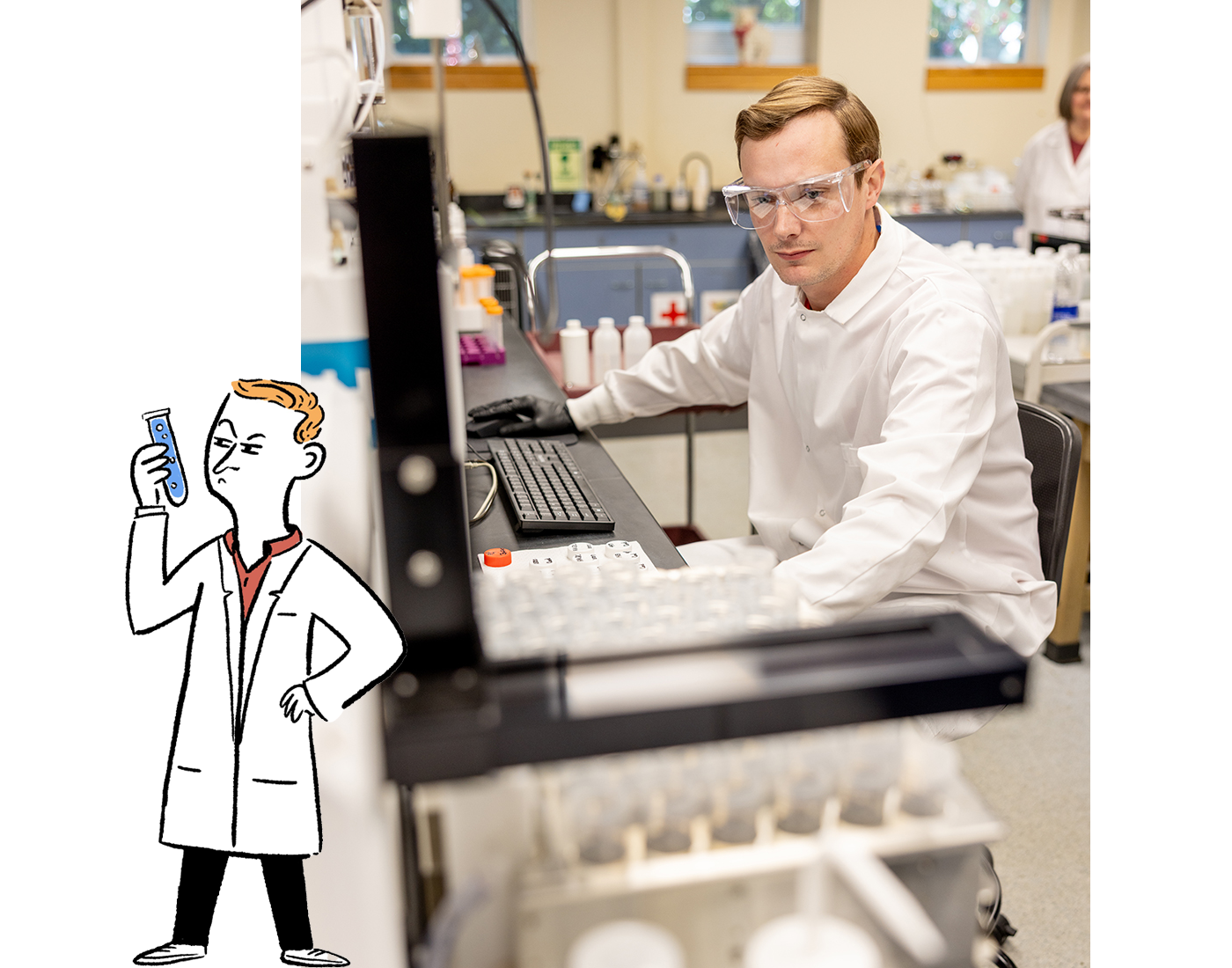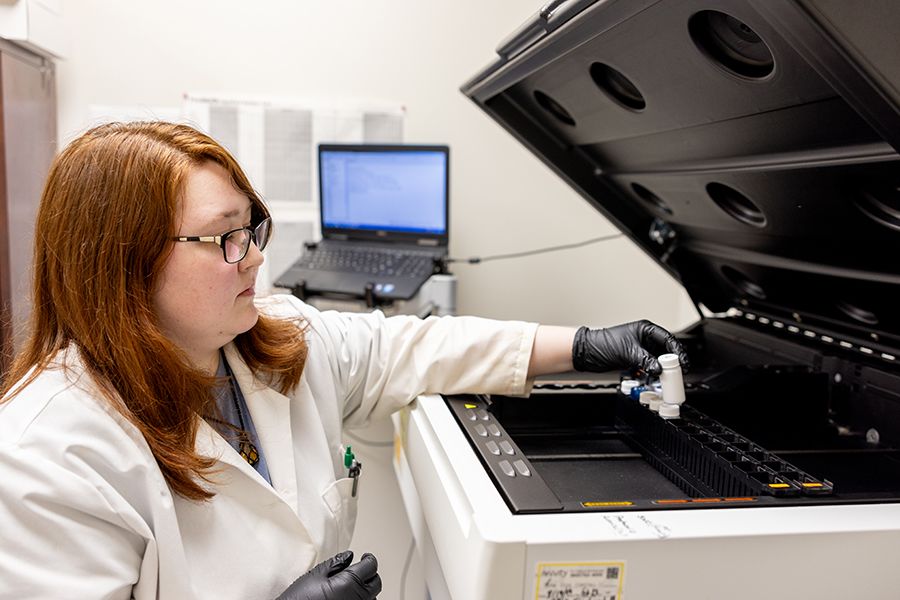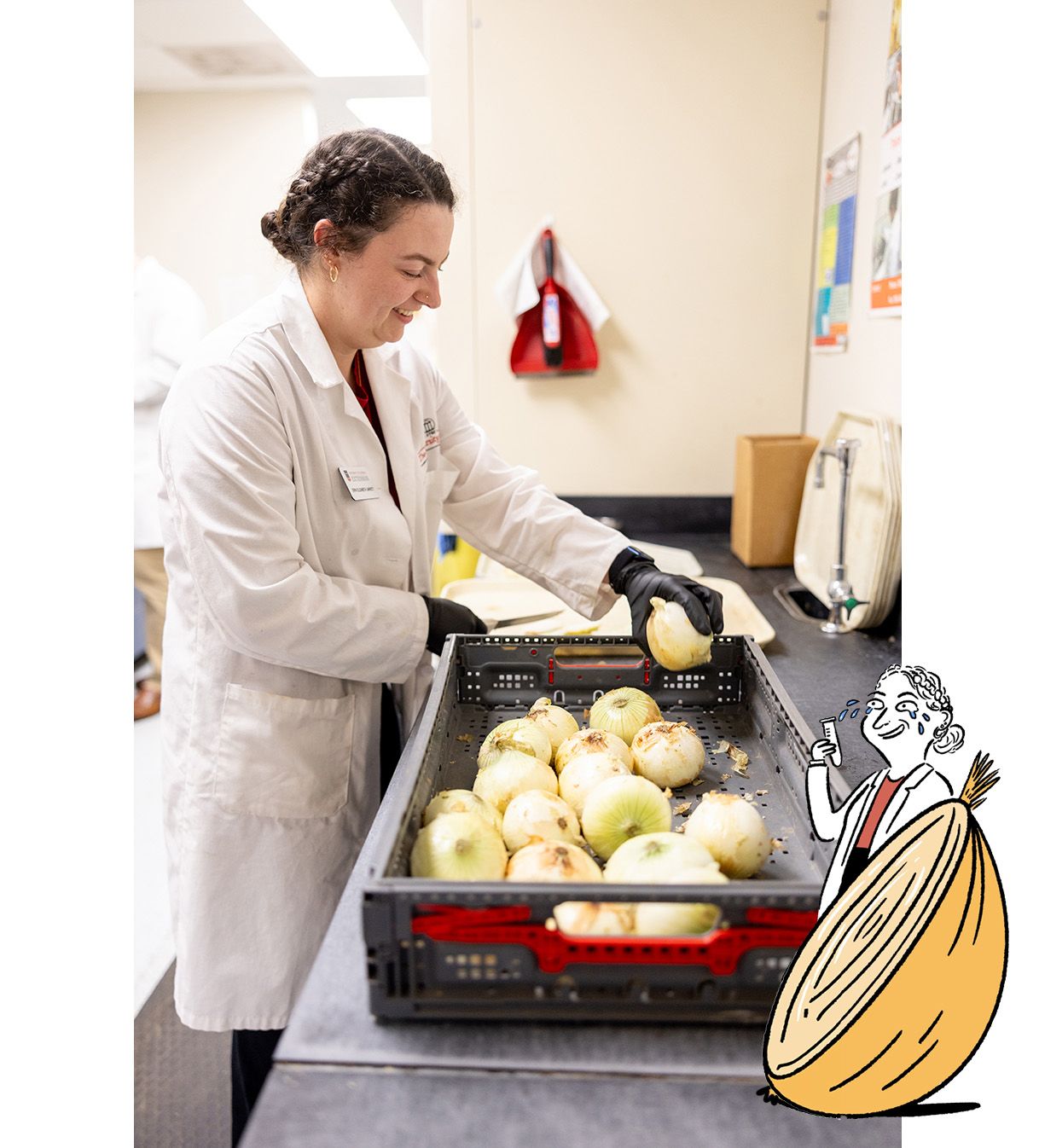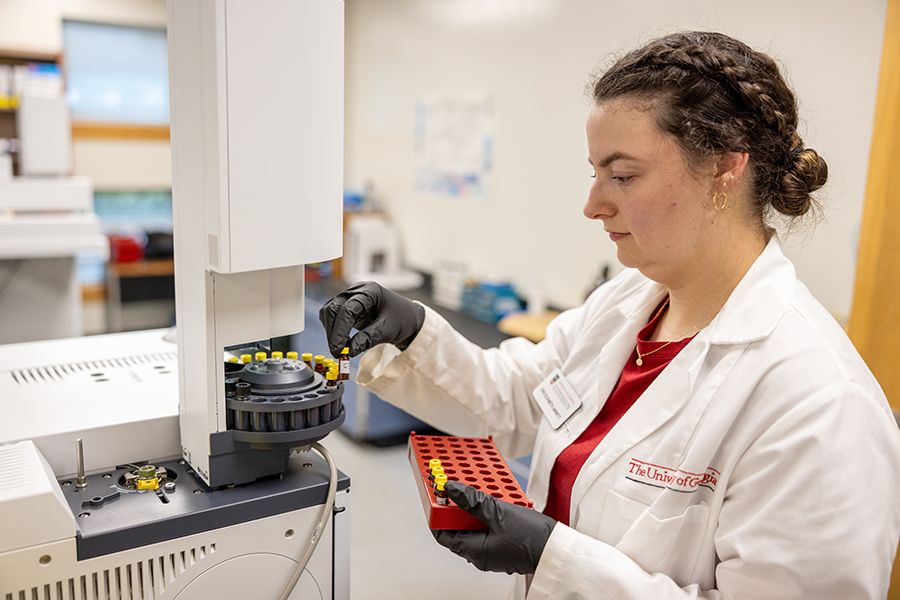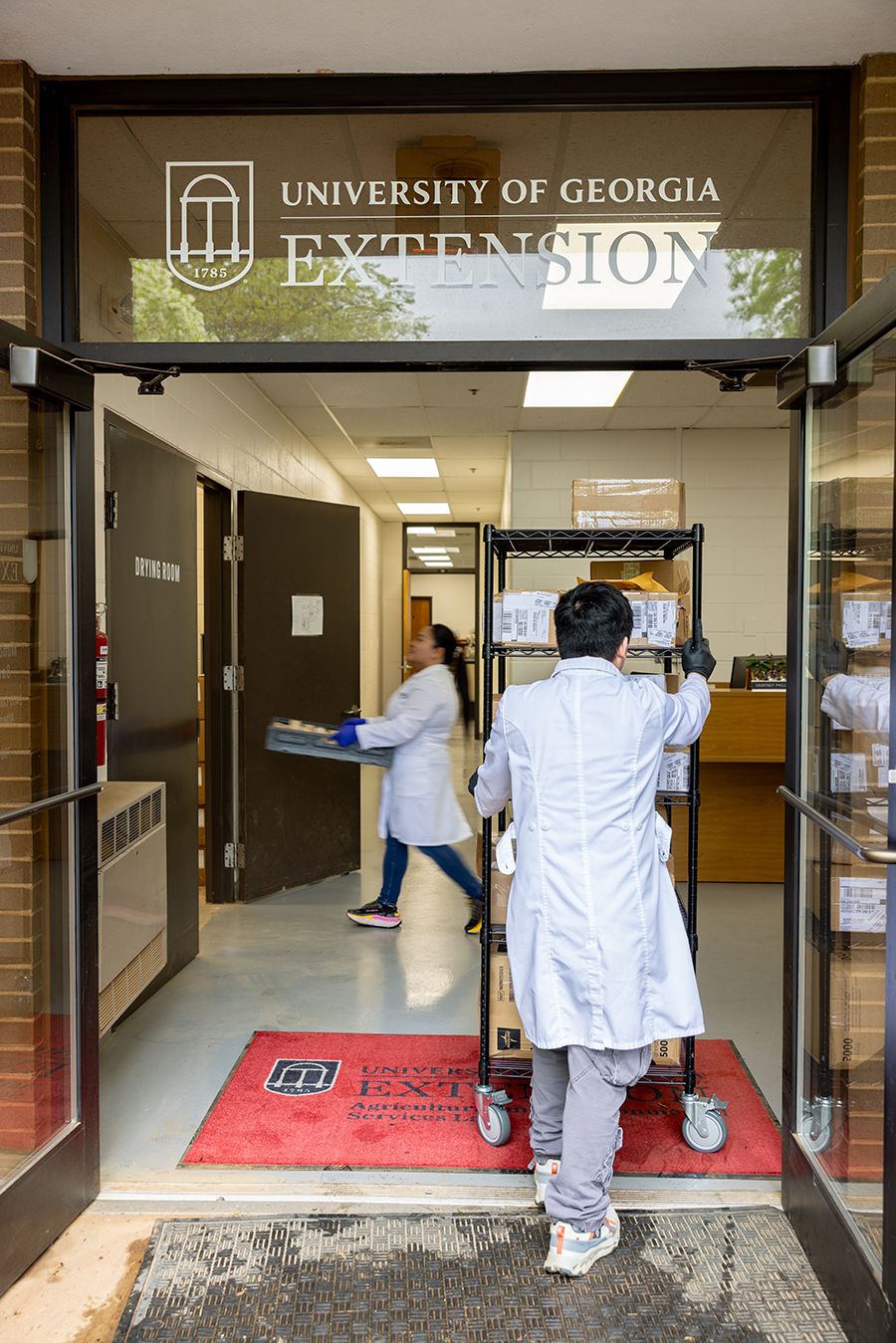275,000 Solutions
Inside UGA’s testing lab that fuels smarter farming in the Southeast and around the globe
275,000 Solutions
The Agricultural and Environmental Services Lab fuels smarter farming in the Southeast and around the globe
Tucked away in Athens, the University of Georgia’s Agricultural and Environmental Services Laboratory (AESL) doesn’t usually make headlines. But step inside, and you’ll find a team of experts testing soil, analyzing water, checking the quality of crops, and helping farmers make smarter decisions every single day.
The team’s work touches nearly every corner of Georgia agriculture — and it started with a few soil samples back in 1938. AESL has since grown from a small station in Griffin to a state-of-the-art facility using some of the most advanced technology in the country.
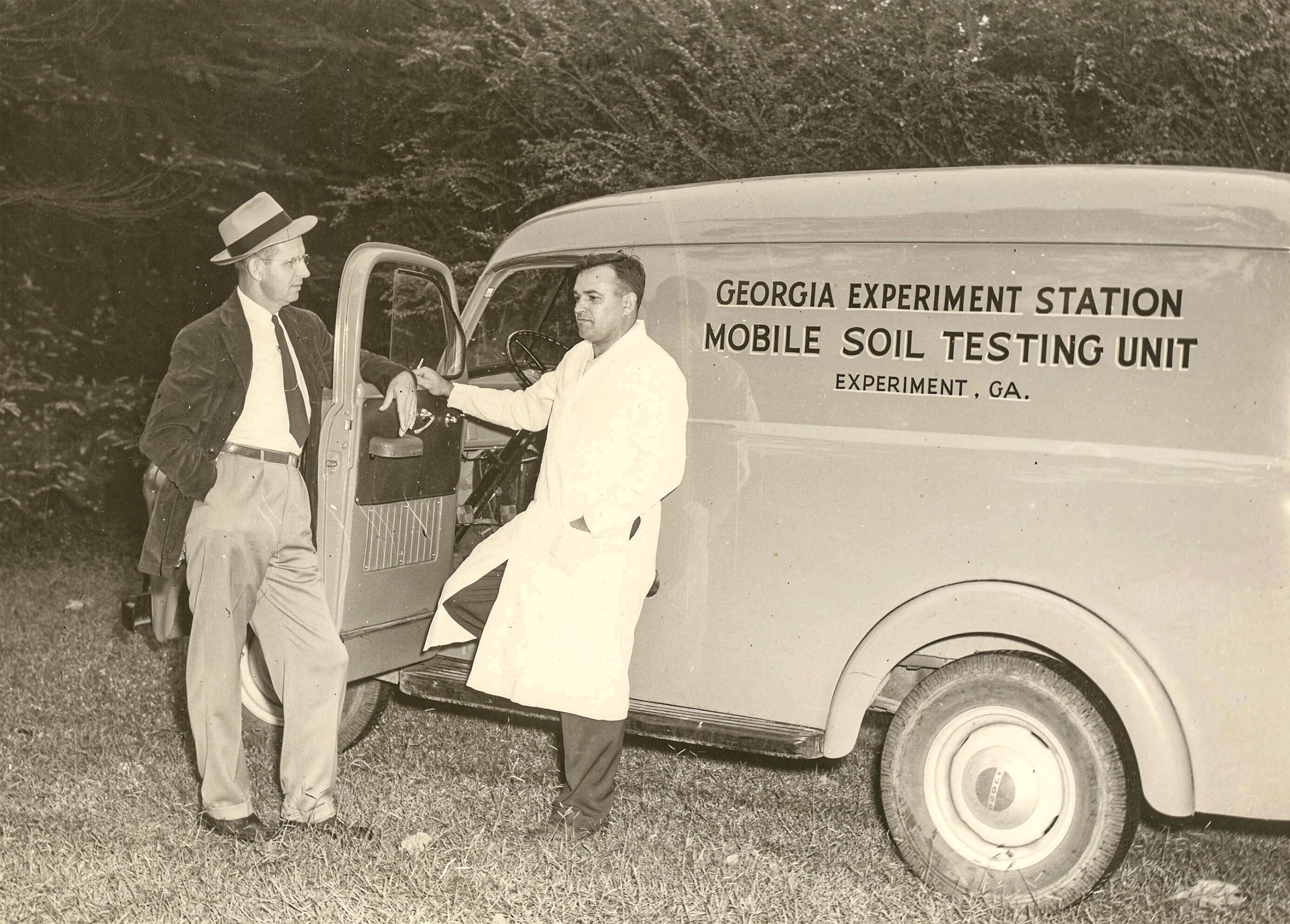
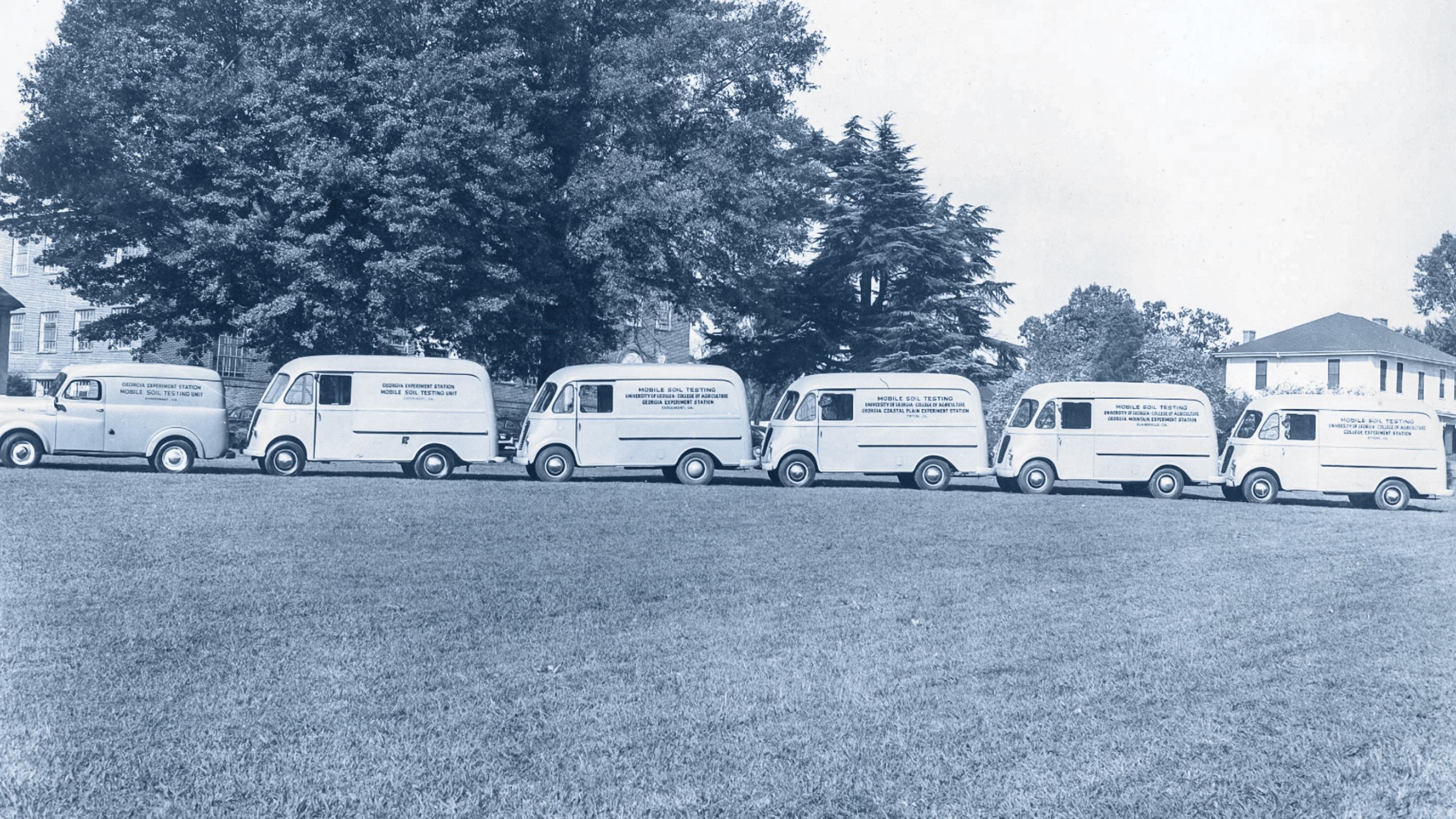
UGA's mobile agricultural testing labs connected rural communities across Georgia with scientific services and recommendations.
UGA's mobile agricultural testing labs connected rural communities across Georgia with scientific services and recommendations.
In the 1950s, lab technicians deployed a small fleet of mobile labs that brought science into the fields. In 2024, AESL processed more than 110,000 samples, performing more than 275,000 tests — each one a potential solution to a question in the field, the greenhouse or the backyard garden.
That’s 275,000 answers about what to plant, how to protect the environment, and how to raise stronger, healthier crops.
AESL conducts more than 70 types of analytical tests across soil, water, plant tissue, animal waste, feed and more — helping clients across the state grow smarter and steward natural resources more effectively. Turnaround times for results average two to three days, but critical samples impacting human and animal health can be processed within 24 hours.
Courtney Phillips puts a scoop from each soil sample bag into a cup to prepare for pH analysis.
Courtney Phillips puts a scoop from each soil sample bag into a cup to prepare for pH analysis.
Jason Lessl, director of the Agricultural and Environmental Services Lab poses for a photo in front of a display showing a map comprised of different soil specimens from each county in Georgia.
Jason Lessl, director of the Agricultural and Environmental Services Lab poses for a photo in front of a display showing a map comprised of different soil specimens from each county in Georgia.
In 2023-24, about 90% of the samples AESL tested came from Georgia, but the other 10% included samples from 38 universities and seven government research stations in 31 states, as well as samples from Iceland, Hong Kong, Vietnam, Namibia and Ecuador.
AESL supports larger-scale agricultural operations with specialized services like total elemental analyses. For those managing livestock or crops, the lab provides robust forage, feed and animal waste testing to improve feed efficiency, environmental compliance and beneficial land application of animal waste.
Accessible to both commercial producers and home gardeners, the lab is deeply committed to public service and environmental protection. With easy sample submission through local UGA Cooperative Extension offices statewide and transparent, affordable pricing — most basic tests start less than $20 — AESL makes cutting-edge science practical and available to all Georgians.
At its heart is a simple mission: provide research-backed, reliable testing and advice that help Georgia’s land and people thrive.
Whether it’s a backyard gardener testing compost or a farmer managing thousands of acres, AESL offers unbiased, science-based answers and trusted guidance that helps keep Georgia’s fields thriving, its food flavorful and its environment protected, one sample at a time.
To assess soil texture, samples from Turkey are analyzed by measuring particle settling rates in a solution. Sand, being the largest and heaviest, settles quickly to the bottom; silt forms a middle layer; and the finest particles, clay, remain suspended the longest. This process helps determine the relative proportions of sand, silt, and clay in the sample.
To assess soil texture, samples from Turkey are analyzed by measuring particle settling rates in a solution. Sand, being the largest and heaviest, settles quickly to the bottom; silt forms a middle layer; and the finest particles, clay, remain suspended the longest. This process helps determine the relative proportions of sand, silt, and clay in the sample.
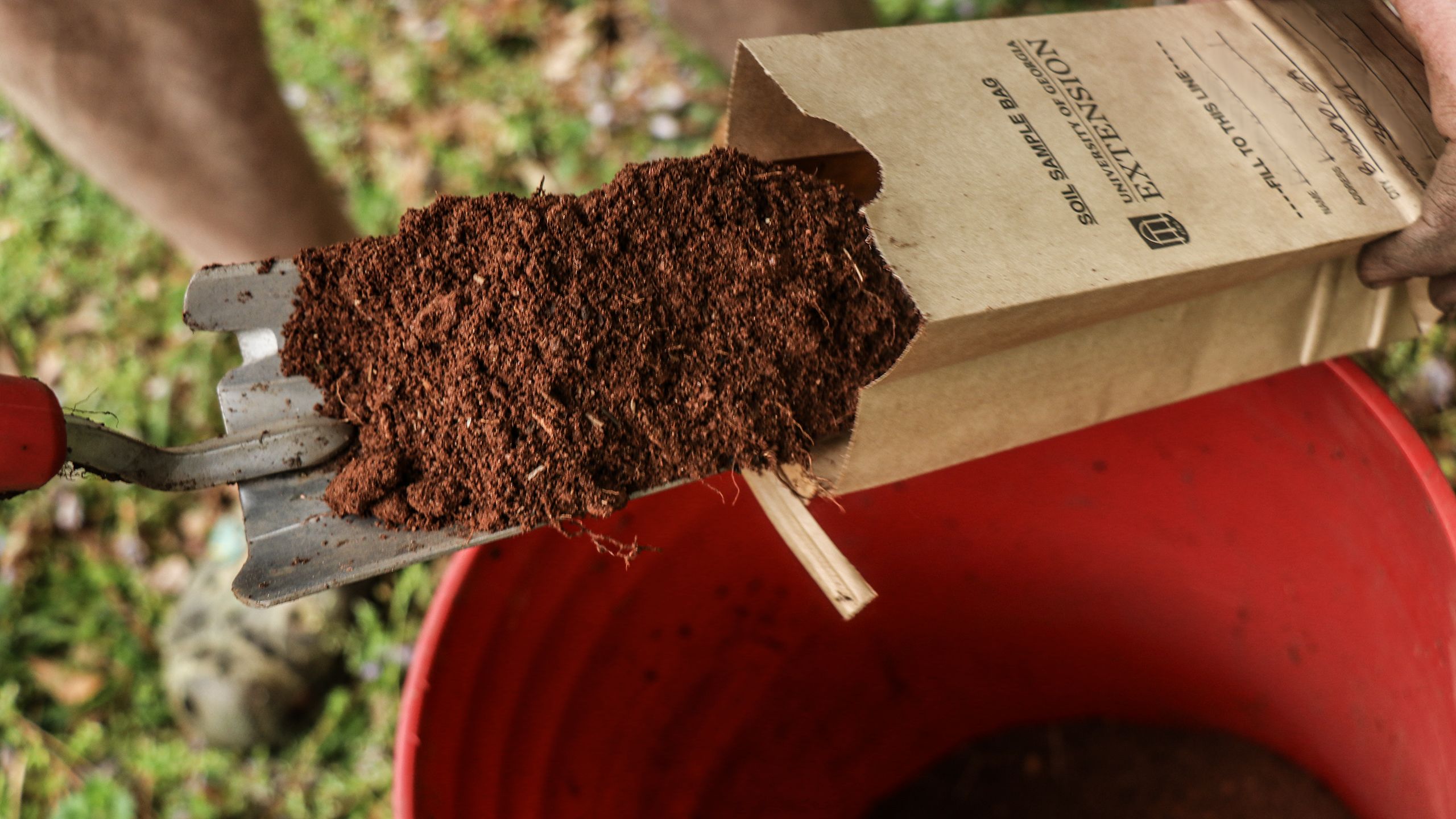

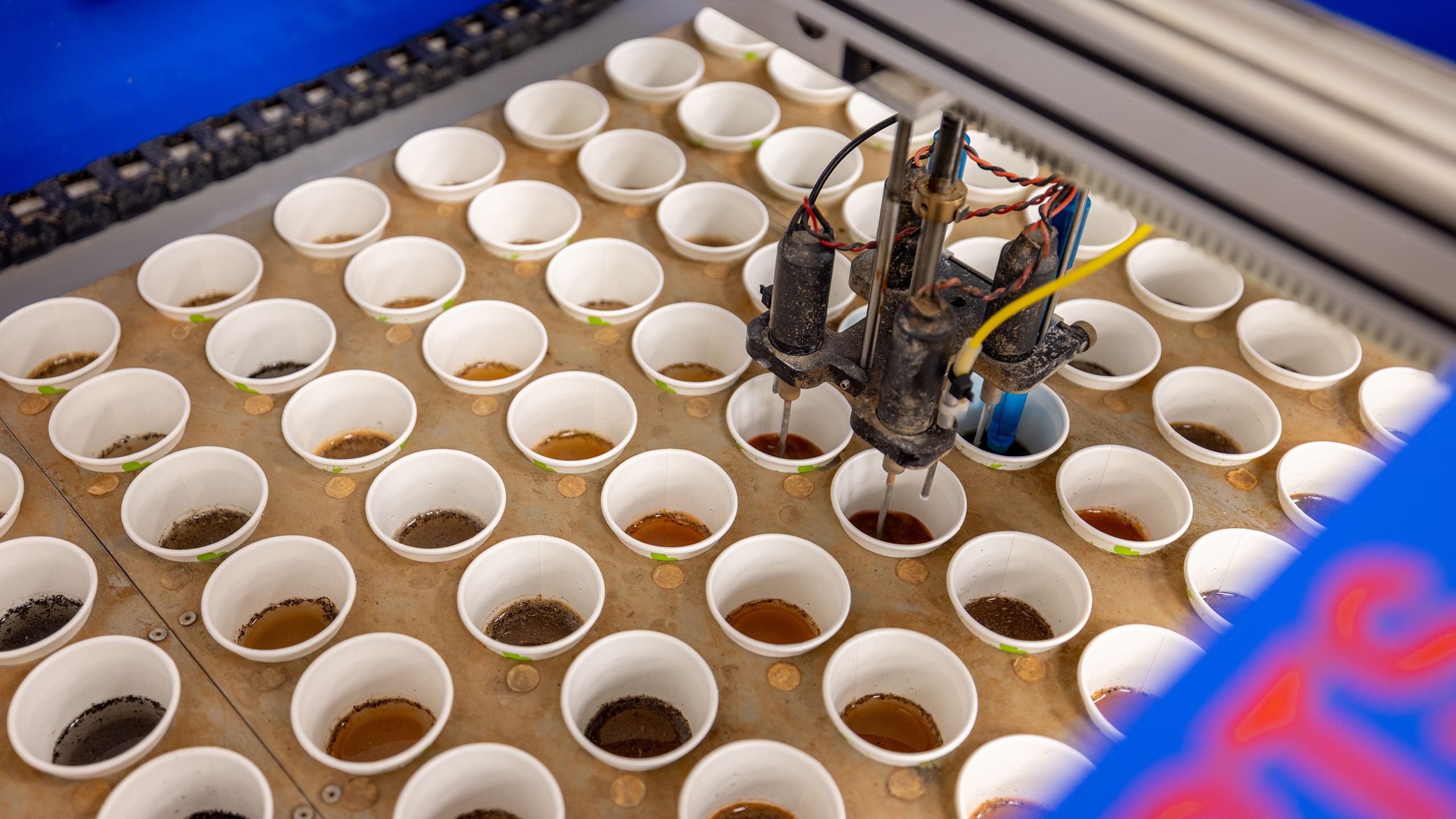

Clay Brady of Foster Brady Farms drops off a soil sample at the Agricultural and Environmental Services Lab on April 7, 2025. Brady tests his soil yearly ahead of the growing season.
Clay Brady of Foster Brady Farms drops off a soil sample at the Agricultural and Environmental Services Lab on April 7, 2025. Brady tests his soil yearly ahead of the growing season.
dig into soil analysis
Whether managing hundreds of acres or tending a backyard garden, Georgia growers rely on healthy soil to produce strong crops and plants. Soil testing, conducted through AESL provides detailed information about nutrient levels and pH, allowing both commercial farmers and hobbyists to apply the right amendments more efficiently.
Local UGA Extension offices serve as the first point of contact for submitting soil samples. Agents help with proper sampling techniques, provide necessary materials like bags and bottles, and explain the associated fees. In addition to handling logistics, Extension agents can assist in interpreting test results, offering recommendations tailored to specific soil conditions and crop needs.
accurate results start with sample prep
At AESL, soil samples typically arrive in small paper bags, each labeled with information about the collection site. Once checked in, the samples are organized into racks for processing. If any samples are damp, they’re first dried in a temperature-controlled oven to ensure consistency in analysis. Once dried, the soil is sieved to remove large debris like rocks, roots and organic matter, and to break up clumps — creating a uniform, fine texture ideal for accurate laboratory testing. This preparation step ensures that nutrient levels and other chemical properties measured in the lab truly reflect the conditions of the soil in the field.
Lab professional Billy Carranza operates the pH analyzer.
Lab professional Billy Carranza operates the pH analyzer.
how nutrient-dense is your soil?
AESL performs a range of soil tests, including pH analysis. Soil pH affects the solubility of nutrients for plants. Testing allows gardeners and farmers to make informed decisions about plant selection and soil amendments to improve plant nutrition. AESL tests the pH of several hundred samples each day with a machine that adds calcium chloride and calcium hydroxide to soil samples and agitates them for 90 minutes.
Steve Floyd, lab manager, pours racks of soil slurry into funnels for nutrient analysis on April 7, 2025. A routine soil test determines the levels of phosphorus, potassium, calcium, magnesium, zinc and manganese in a sample.
Steve Floyd, lab manager, pours racks of soil slurry into funnels for nutrient analysis on April 7, 2025. A routine soil test determines the levels of phosphorus, potassium, calcium, magnesium, zinc and manganese in a sample.
Reliable support for researchers
Behind the lab, a building holds dozens of racks bearing flats of soil samples. Samples submitted by researchers are retained for two years in case retesting is required.
“The biggest distinction between UGA’s AESL and every other lab is not our volume, but The Diversity of Samples we process. we are the main lab for most of the southeastern ag community.”
– Jason Lessl, Soil, Plant and Water Lab program coordinator
Safeguarding feed and forage
Feed lab manager Majid Ronaghi prepares hay samples by cutting and drying them in an oven overnight to remove moisture. The dried samples are then ground, packed into vials and analyzed using Near Infrared Reflectance Spectroscopy (NIRS), which measures nutrient levels, fiber content and digestibility. Delivering results in just two minutes, NIRS replaces traditional wet chemistry methods that can take up to three weeks. This rapid analysis is especially valuable for cattle producers, helping them optimize feed use and quickly identify poor-quality or dangerous forage.
plant health monitoring
Uttam Saha, program coordinator at AESL’s Feed and Environmental Water Laboratory, weighs a plant material sample for ammonium and nitrate chromatography. This test measures nitrogen levels in liquid plant samples, identifying different forms of nitrogen, which serve as indicators of plant health.
industrial and material analysis
In addition to soil, water, and feed, the Agricultural and Environmental Services Lab tests a wide range of materials—from bird feathers and fertilizer to compost, sludge, sorghum syrup, lime slaker grits, and fly ash, a byproduct of paper processing.

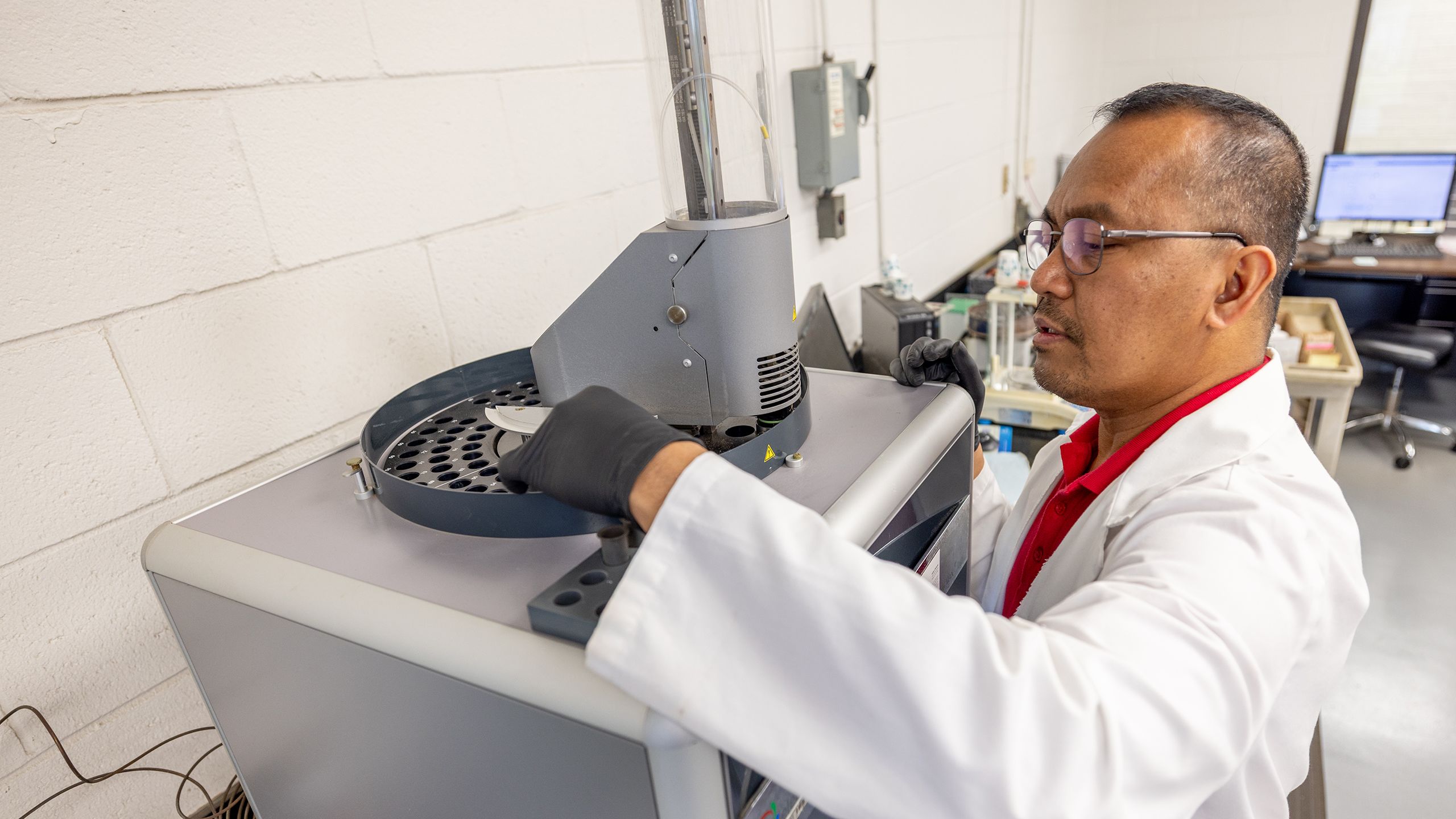
Veggies microwaved, digested and toasted with an 18,000 degree plasma argon flame, just like mama used to make
To assess nutrient levels in plant tissue, samples first undergo microwave digestion — a process that uses pressure, heat and nitric acid to break down plant material into a liquid form suitable for analysis. After digestion, the pressurized containers of liquid samples are opened in a vent hood and transferred into small vials in preparation for inductively coupled plasma optical emission spectroscopy.
Lab technician Jeprey Gemao uses Inductively Coupled Plasma Mass Spectrometry (ICP-MS) to measure levels of nutrients such as calcium, magnesium, zinc, and iron in plant samples.
Lab technician Jeprey Gemao uses Inductively Coupled Plasma Mass Spectrometry (ICP-MS) to measure levels of nutrients such as calcium, magnesium, zinc, and iron in plant samples.
ICP-MS exposes the digested samples to a plasma argon flame reaching 18,000 degrees Fahrenheit to precisely measure elemental concentrations such as phosphorus, potassium, magnesium, and zinc. This analysis helps guide fertilizer recommendations based on these readings.
A steel crucible glows in the combustion analysis machine. The device reaches 1,652 degrees Fahrenheit when it burns a sample.
A steel crucible glows in the combustion analysis machine. The device reaches 1,652 degrees Fahrenheit when it burns a sample.
Combustion analysis
UGA’s Agricultural and Environmental Services Laboratory uses combustion analysis to measure total nitrogen and carbon in soils, plant tissue, compost, and other samples. This method heats the sample to very high temperatures with lots of oxygen, turning the carbon into carbon dioxide and the nitrogen into gases, which are then measured by detectors. Combustion analysis is a fast and accurate way to measure total nutrients to assess overall soil health, compost quality or carbon storage.
Water testing
Some municipalities send samples from public swimming and recreational waters — such as lakes, rivers and coastal areas — to AESL to screen for potential health risks, including sewage contamination and harmful algal blooms. Drinking water can be assessed for qualities such as hardness and alkalinity or the presence of dangerous contaminants like lead. The lab also performs water tests required for closing home loans.

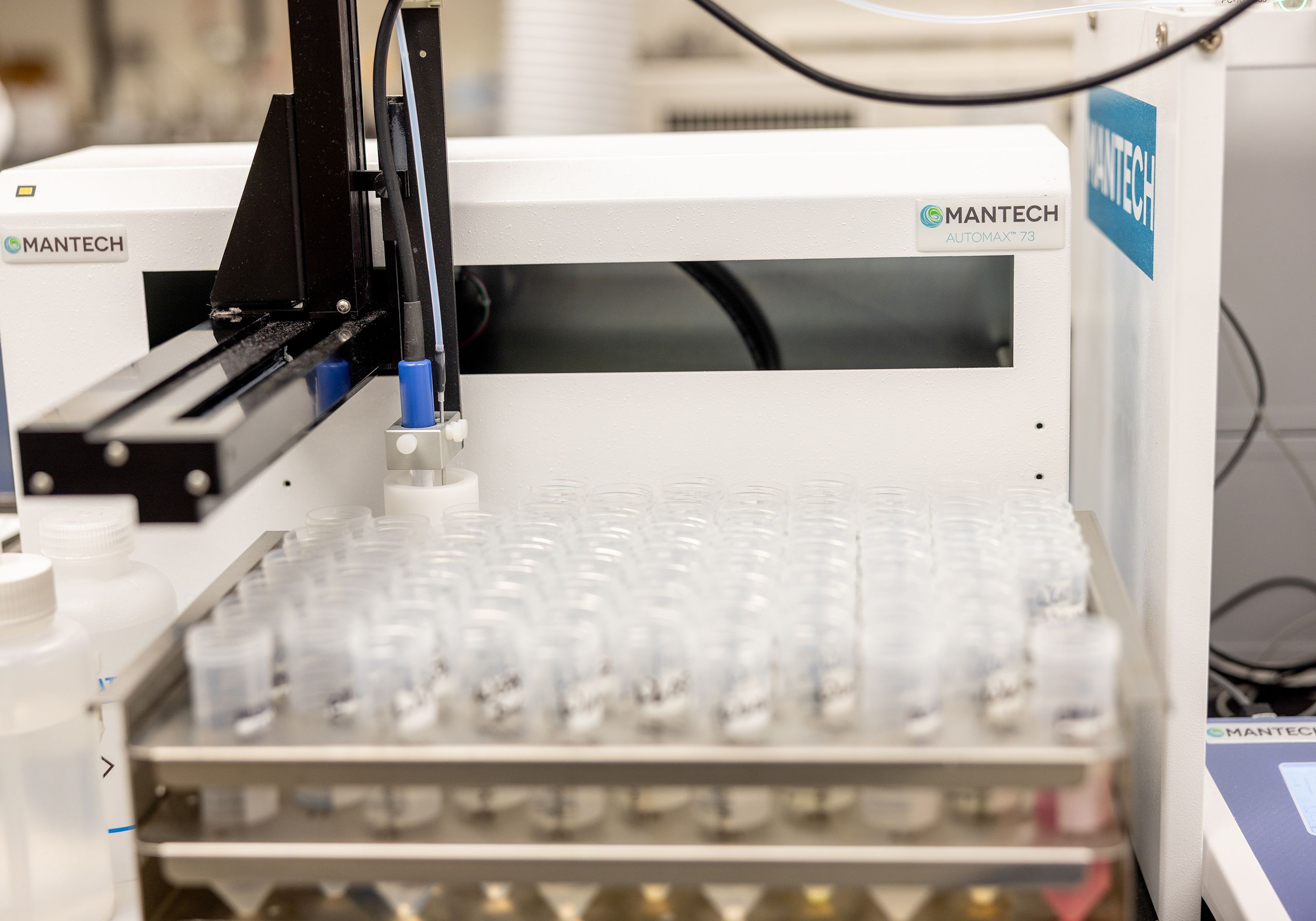
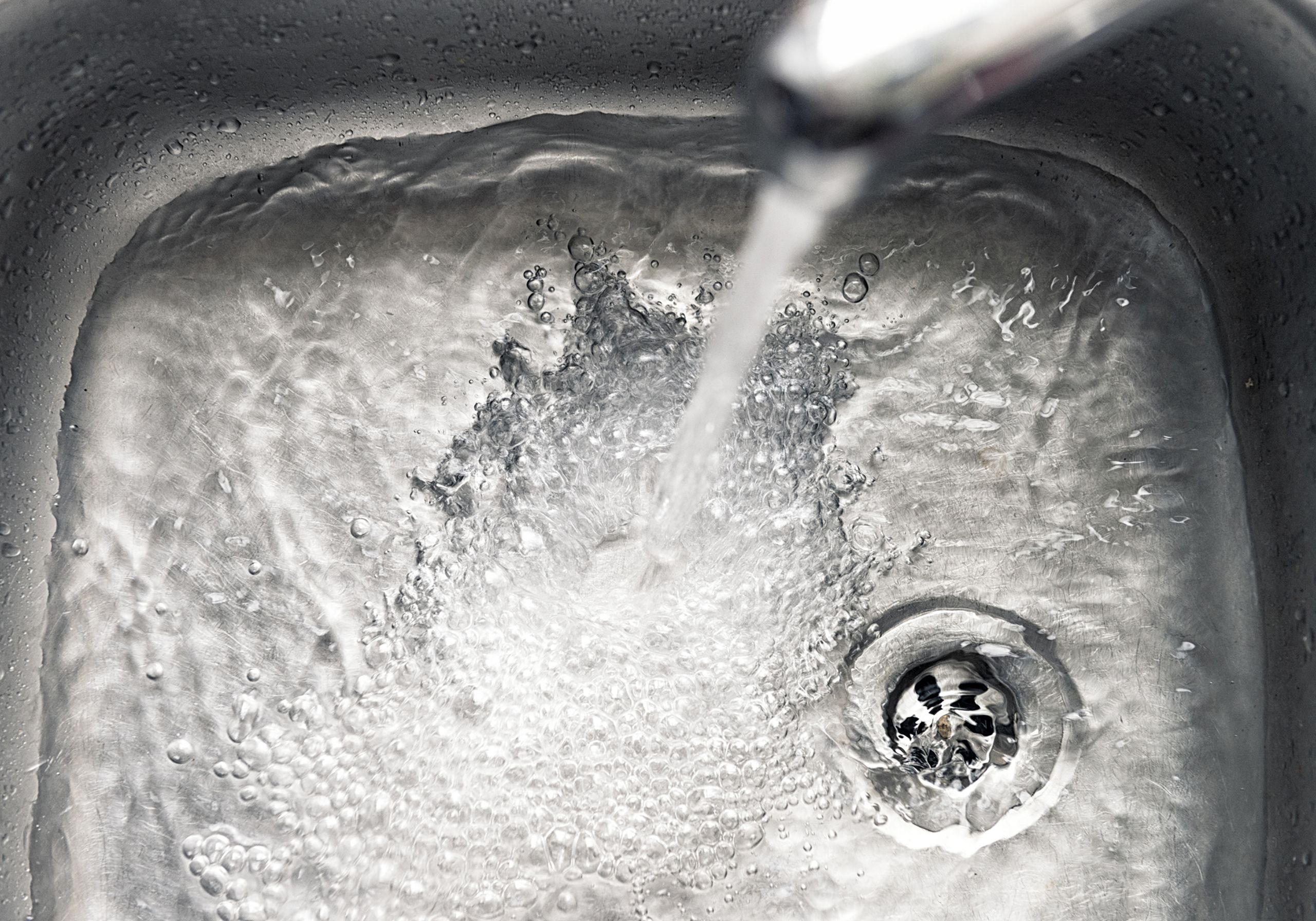

Coliform testing
Drinking water is analyzed for the presence of total coliform bacteria, fecal coliforms, E. coli, and other microbial indicators of contamination. If total coliforms are absent, it’s unlikely that other harmful microbes are present. This is one of the most widely used methods for detecting fecal contamination in surface and well water.
"Automated water analysis system performing a conductivity test using robotic sampling on a tray of water vials."
Jonathan Fox monitors a conductivity test.
Jonathan Fox monitors a conductivity test.
Conductivity testing
Conductivity testing measures how well water can carry an electrical current, which reflects the amount of dissolved salts and minerals in a sample. Higher conductivity often indicates higher levels of dissolved substances. Conductivity testing helps verify water quality results and serves as a key indicator of potential contamination.
(Photo by Katie Walker)
(Photo by Katie Walker)
“Approximately 460,000 families live on properties with a well for their household water needs including drinking water. There is no agency that is testing these wells to ensure the water is safe to drink. This is where we come in.”
– Uttam Saha, Feed and Environmental Water lab program coordinator
Lab paraprofessional Kylie Mosley loads samples into the radon scintillation counter.
Lab paraprofessional Kylie Mosley loads samples into the radon scintillation counter.
Radon can contaminate water, too
Lab paraprofessional Kylie Mosley prepares water samples for radon scintillation testing, carefully opening each bottle just enough to preserve the gas trapped in air bubbles. Radon is a naturally occurring radioactive gas that can pose health risks when present in drinking water, making accurate measurement essential – a minimum of two vials are tested for every submitted sample.
Verifying Vidalias
To earn the name “Vidalia,” onions must meet specific flavor criteria — and AESL plays a key role in ensuring they do. The lab tests for volatile compounds such as the lachrymatory factor — the chemical that makes your eyes water — as well as sulfur content, which heavily influences flavor. While sulfur is essential for onion growth, excessive levels can result in a harsh, pungent taste. The UGA Department of Food Science and Technology and the USDA Agricultural Research Service helped identify the specific flavor markers that define a true Vidalia onion, and AESL tests thousands of batches each year to ensure Georgia’s signature onion lives up to its sweet promise.
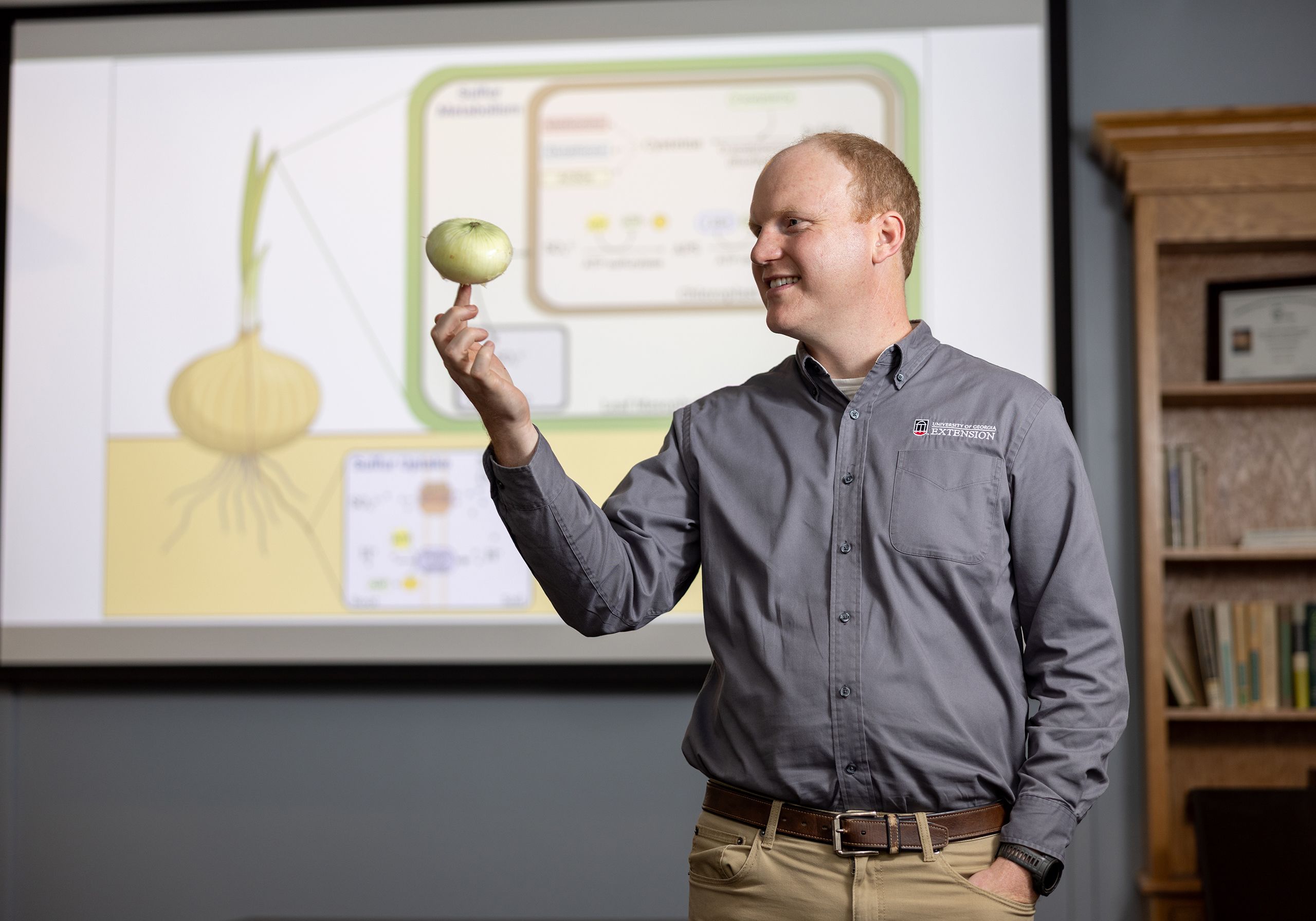
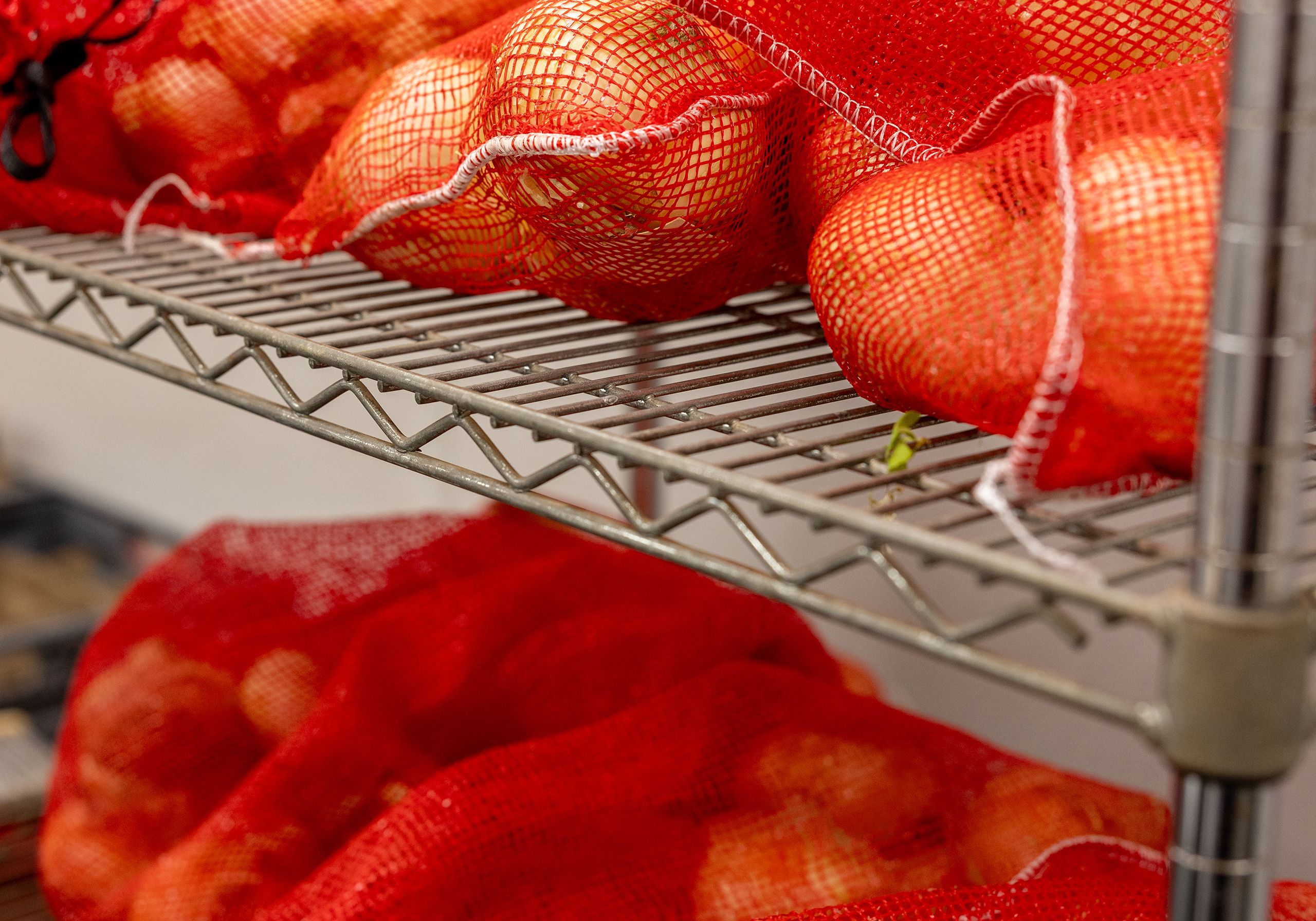

what is a vidalia onion?
An onion by any other name would not taste as sweet. Only onions grown in southeastern Georgia's sandy, low-sulfur soils can be called Vidalia onions. Protected by federal and state regulation, Vidalias are a specific type of Granex hybrid yellow onion cultivated in a designated 20-county region. Their signature sweetness comes from the unique soil and climate of this area, making them famously mild and perfect for eating raw. The Vidalia Onion Committee governs the name “Vidalia,” requiring each batch of onions to be tested for pungency and pyruvic acid levels.
Erin Jarrett, Crop and Environmental Quality Lab manager slices onions in preparation for testing. They are then squeezed in an industrial press to extract juice for analysis.
Erin Jarrett, Crop and Environmental Quality Lab manager slices onions in preparation for testing. They are then squeezed in an industrial press to extract juice for analysis.
The juice is pipetted into vials and mixed with a vortex mixer, releasing cellular compounds for analysis. AESL then measures these compounds to determine whether the onion meets the standards to qualify as a Vidalia.
The juice is pipetted into vials and mixed with a vortex mixer, releasing cellular compounds for analysis. AESL then measures these compounds to determine whether the onion meets the standards to qualify as a Vidalia.
After vortexing, samples are transferred to smaller vials and spun in a centrifuge. This separates components of the onion juice based on density. This enables AESL to assess the presence of sugars and sulfur-related compounds in each sample.
After vortexing, samples are transferred to smaller vials and spun in a centrifuge. This separates components of the onion juice based on density. This enables AESL to assess the presence of sugars and sulfur-related compounds in each sample.
Billy Carranza, laboratory professional at AESL, wheels a delivery of soil, water and plant samples into the lab for processing on April 7, 2025. In 2024, the lab received more than 110,000 samples for testing.
Billy Carranza, laboratory professional at AESL, wheels a delivery of soil, water and plant samples into the lab for processing on April 7, 2025. In 2024, the lab received more than 110,000 samples for testing.
Learn more about AESL by visiting their website.
